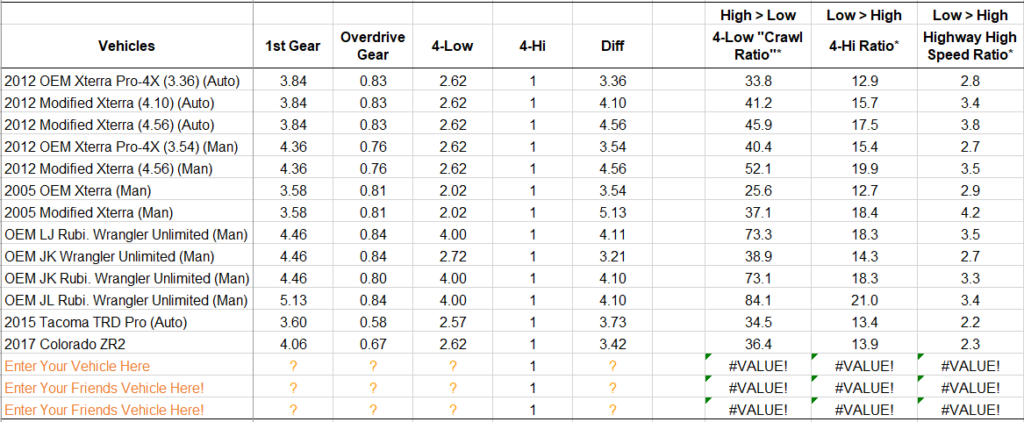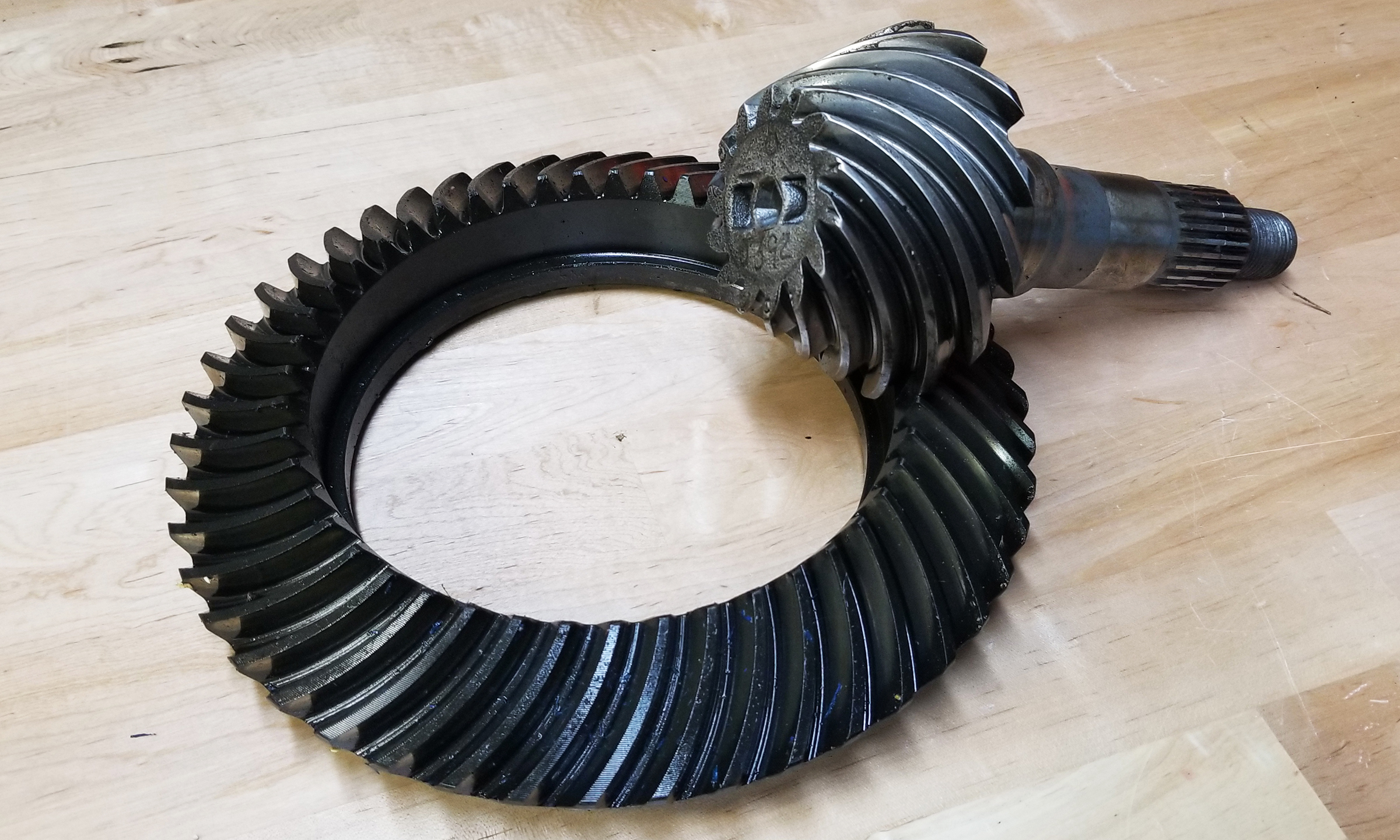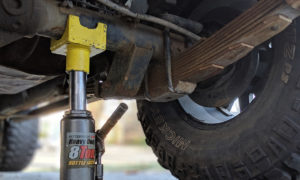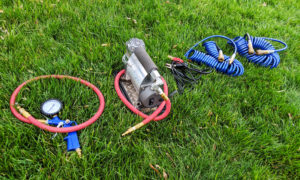After destroying my differential gears one day on the trail I was considering changing my differential gears for a different ratio in my Xterra. I realized I wanted to compare my options with the ratios some of my friends are running in their trail vehicles. I figured that since we enjoy the same trails together that we’d want similar ratios and tire sizes. I made the spreadsheet below to allow me to quickly and easily compare total gear ratios of several of my friends vehicles with my own taking into account differences in tire size as well. Since my vehicle, and many of my friends vehicles, also see highway driving it was important to balance the torque in first gear in 4-Low with highway driving in 2-Hi and 5th or 6th gear.
If you own a recreational SUV or truck eventually you’re going to hear about changing your differential gears. This is generally done because all the gears in the drivetrain installed at the factory were specifically chosen to work well with the OEM engine and tire size, and have been optimized to give the right amount of torque for the performance envelope they desired while also delivering the best fuel economy.
However, as soon as you start swapping out or adding aftermarket parts you might see a decrease in performance. Increasing the tire size and/or changing the type, such as from a road tire to a mud terrain, means you’ll see a difference in performance because the new tire will require more torque to turn, you will see changes with lower mpg’s, and feel it become more sluggish while driving. Start adding other things like extra weight from skid plates and heavy bumpers and you’ll really notice a difference in performance.
The total gear ratio of the vehicle is calculated by multiplying three different gear ratios together. These ratios are the transmission gear in use, the transfer case gear in use, and the differential gear. The transmission gear ratios that are most important are the first gear (used for low speed off road driving) and we’ll look at the highest gear (typically 5th or 6th) to understand high speed road performance. In the transfer case 2-HI and 4-HI typically are a 1:1 ratio, while trucks with a 4-Low gear ratio have a higher ratio to allow for more low end torque in off road situations. Finally the differential gear is fixed and is a ring and pinion gear set located in the front and rear differentials of the vehicle. The differential gear ratio can only be changed by physically installing different gears before you hit the trail.
Because changing the transmission and transfer case gears is often more involved and expensive most users first consider changing the differential gears if they want to change the overall gear ratio of their drivetrain. Because this impacts both on road and off road performance I wanted to understand how new gears would impact my vehicle across both ends of the performance spectrum.
If you don’t know how differentials work then I highly recommend this great video explaining just that. It was made by GM in the 1930’s.
Vehicle Spec Inputs
My spreadsheet is setup so that you input a vehicles 1st gear and overdrive gear from the transmission, the 4-Low gear ratio, and finally the differential gear ratio. I wanted to enter this information for my vehicle as it came from the factory, my vehicle with a few different differential gear options I was considering, as well as the setup of several of my friends whose vehicles seem to work well on the trails we enjoy together.
Note that as you start modifying the spreadsheet, only change the values of cells with orange text! Changing cells that are any other color could break the functionality of the calculator! Also note that while gear ratios are technically a ratio of some number, often in relation to one (such as 4:1 or “Four to one”) for ease of readability the entire spreadsheet drops the “:1” and it is assumed. We’ll also just discuss the first number throughout this post.
I got the gearing information for different vehicles from driverside.com. For example, here is the page for my OEM 2012 Nissan Xterra, Pro-4X trim. You can see in the table that it has a 3.84 first gear, 0.83 overdrive gear, the transfer case 4-Low ratio is 2.62, and the OEM differential gearing is 3.36. If I had the manual transmission then I would have different 1st and overdrive gearing, and if I had a different trim I would have a different differential gear, so making sure to select your make, model, trim, and drivetrain type accurately is key for correct results.
Since I was considering upgrading my 3.36 factory differential gear ratio up to either 4.10 or 4.56 I made two new rows for my vehicle with everything the same except the diff gears.

Using the driverside.com website I was also able to fill in the specs for friends vehicles to compare to. Since I drive with people that drive a variety of off road vehicles I put many of the more popular makes and models in. In the spreadsheet I have already populated rows for the manual Jeep JKU and JKU Rubicon as well as the JLU Rubicon, the late model Tacoma TRD Pro, the Colorado ZR2, and some customized setups as well.
If your vehicle (or friends vehicles) aren’t on the list add them and their specs at the bottom of the table in the rows labeled “Enter Your Vehicle Here” and “Enter Your Friends Vehicle Here.” Then add the 1st, overdrive, 4-Low, and diff gear ratios in the proper columns replacing the orange question marks.
Tire Size and Speed Inputs
Next we’ll add information about what size tires and speeds you’re interested in seeing performance around. For me I wanted to compare the OEM tire size of 32in, my current tire size of 33in, and my planned future upgrade size of 35in. I also was interested in seeing performance at 3mph for the off road situations as well as highway driving performance at 70mph.
Note that your needs may be very different. You might want to see what 37’s, 40’s or those sick 56in tires might be like with your setup. Or you may have a trailer queen that never goes above 25mph. Here is where you put in that info to match the tire size and speed ranges that encompass the performance envelope and possible upgrade path for your vehicle.

Total Gear Ratio Calculation
Once the vehicle gearing information was entered the spreadsheet automatically calculated the total gear ratio for the vehicle using different combinations of gearing. It calculates total gear ratio in 1st gear in 4-Low (Off Road “Crawling”), 1st gear in 4-Hi (general use off roading), and Overdrive gear in 2-Hi (Highway driving).
As an example let’s run through two of these. The total crawling gear ratio my 2012 Nissan Xterra, Pro-4X, had from the factory was calculated the following way:
Low Speed Crawl Ratio:
- 1st gear = 3.84
- 4-Low gear = 2.62
- Differential gear = 3.36
Total Crawl Ratio is 3.84 x 2.62 x 3.36 = 33.8!
We can also calculate my gear ratio during highway driving by assuming I’ll be in 2-Hi and in overdrive.
Highway High Speed Ratio:
- Overdrive gear = 0.83
- 2-Hi gear = 1
- Differential gear = 3.36
Total Highway High Speed Ratio is 0.83 x 1 x 3.36 = 2.8
I can then use these additional rows with new differential gear ratios to see the change in overall gearing. For example, I can see that just by stepping up to a 4.10 gear ratio in my differential means I’ll have a higher ratio than my friends driving non-Rubicon JKU’s, Toyota Tacomas and Chevy ZR2’s! I can also see that even with the deepest gearing I’m considering, a 4.56, that my total crawl ratio remains just over half of what the JLU Rubicon comes with from the factory (with the manual transmission).

RPM Calculations
The last section of the main table calculates your engine RPM’s in different driving scenarios, taking into consideration the gearing combination that would be in use for each. It then also calculates how that RPM changes depending on which tire size you’re running. Here is where our tire size and speed inputs are used.
In my case my big concern is selecting a gear ratio that is too large. While a larger (deeper) gear ratio than I have will make for more spirited and torquier driving around town and on the trail, it will also push my RPM’s up on the highway at a given ratio/tire size combo. Using this table and looking at the column for 33in tires which I currently have installed (in the cells colored orange) I can see that by increasing my gear ratio to 4.10 or 4.56 I will increase my RPM’s on the highway about 450 or over 700 RPMs respectively! If I ever upgrade to 35in tires the RPM increase drops only a little, to just over 400 or 670 respectively. Since I drive on the highway frequently this is a big deal. I can also see that my friend with a manual Xterra on 35’s with 4.56 gearing would be running about 100 RPM lower than I would in my automatic Xterra on 33’s if I upgrade to 4.10 gearing!
On the other end of the spectrum I can also see that just putzing around at the off road park in 4-low at 3mph will also see an increase my RPMs (in cells colored green). My two gear ratios will increase my RPMs in this situation either a little over 200 or just over 350 RPMs. That to me is less of a big deal, but is important to note.

Planning for Future Upgrades
At the end of the day our vehicles are never actually finished, right?! I was planning to upgrade my gearing, but may upgrade my tire size in the future when I wear these ones out. I wanted to make sure that my total gear increase would be enough to accommodate a larger tire size in the future and still give me a mechanical advantage over the OEM gearing. To help with this I added a little section near the bottom of the spreadsheet to help compare these ratios.
Again, change the inputs in orange for your situation. For me I want to compare the OEM differential gearing (3.36) and current tire size (33’s) combination vs a potential future setup with 4.10’s on 35’s.
As you can see with the 4.10’s and 35’s I still have a gear ratio that is 15% deeper compared to my tire size than my current setup on the OEM gearing.

A Helpful Tool
Since I made this spreadsheet, and decided to go with 4.10’s, I have been very happy with my setup both on and off the road. Around town the 4.10’s give my Xterra the pep it lost when I went to bigger mud terrains and and added all the armor. I really appreciate the extra torque I have now while off roading, and in many situations can let the vehicle almost crawl over obstacles on it’s own, or engine brake much more effectively going down hills.
On the other end of the spectrum my driving on the highway has also improved, giving me just a little more torque when I need it, but not driving my RPM’s through the roof. Before the gearing upgrade I just didn’t feel like I had any torque on the highway, and struggled to accelerate up long hills without just flooring it.
Something that might surprise you is that I saw no decrease in overall fuel economy! While my RPMs increased across the board I think I used to have to drive at a higher RPM just to get the torque I needed in my daily driving. Now that I have more torque from the gearing I can cruise around town at a lower, closer to stock, RPM range!
I know a few friends have already requested this spreadsheet and so if you’re reading this I hope it can help you too!




Dude this is fucking amazing. And exactly what I needed. I have a 2012 Pro 4X with the manual and just bumped up to 33s and off the line It’s so sluggish now. (I actually had 31s previously) I feel like all the guys on the forum need to see this! I’m not really on there but feel like getting on there to share your work man. Thank you Good stuff..
Thanks! I’m glad you found this useful! The math is fairly straight forward once you know the terms, but how that “feels” is totally subjective. That’s why I made this, to help me, and others, be able to understand and anticipate that change in “feel” throughout the driving experience with different gearing setups.
Awesome spreadsheet. I’m thinking of changing differential to increase towing in my pickup and was curious how it would change my cruising RPMs. Thank you!
I’m glad you found this useful! Good luck with your re-gearing!